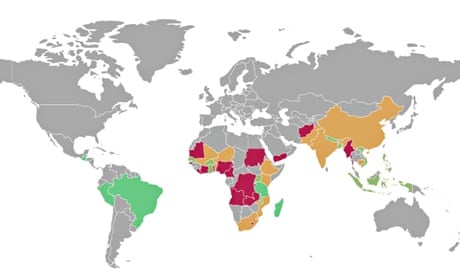Some of the world's poorest countries are taking significant strides in addressing undernutrition and hunger, according to new evidence from the hunger and nutrition commitment index (Hanci) 2013. Guatemala, Peru, Malawi, Brazil, Madagascar, Nepal and Tanzania were rated highly committed, but Burundi and Liberia have made progress on action to reduce chronic hunger and undernutrition.
Findings from Hanci, launched on 25 June, show that in some countries, where there has previously been little action on these issues, significant efforts are now being made, including putting in place new laws and policies and increasing public investment. Burundi, for example, has improved access to clean water and sanitation and increased agricultural spending – significant improvements in a country with a hunger status of "extremely alarming", according to the global hunger index.
Hanci measures political commitment to reducing hunger and undernutrition in 45 high-burden developing countries, and compares their policies, laws and spending efforts. Where hunger is the result of an empty stomach, undernutrition is caused by multiple factors including poor diversity of food, lack of clean water and sanitation, inadequate feeding practices for infants and young children, and unavailability of healthcare. Therefore, government interventions must address both hunger and undernutrition, and commitment to tackling one does not necessarily automatically translate into tackling the other.
By shining a spotlight on how governments prioritise action differently on hunger and undernutrition, Hanci helps citizens to hold their governments to account. Annual updates can show how governments perform over time. Where evidence shows that action is lacking, more may be demanded. Conversely, where it shows that governments are taking positive steps, fair praise may reinforce further action.
This is needed because levels of hunger and undernutrition remain unacceptably high. According to the UN's Food and Agriculture Organisation (FAO), between 2011-2013, 842 million people (one in eight) worldwide were estimated to suffer from chronic hunger. Recent research found that in many countries in Africa and south Asia, many children under five are stunted, or are too short for their age, and that undernutrition contributed to 45% of deaths of under-fives in 2011. Greater efforts by governments, businesses, civil society groups and citizens are needed to eradicate these scourges.
Nevertheless, it is evident that motivations for prioritising action on hunger and nutrition differ over time, and from country to country. Unlike Burundi, other countries with high levels of hunger and undernutrition are sliding back in their efforts. In Sudan, for example, Hanci shows that on many indicators, such as access to water and sanitation and women's economic rights, such efforts are weakening, threatening future progress.
Hunger and undernutrition are shaped by political choices, which are particularly important in the global hunger and undernutrition hotspots of sub-Saharan Africa and South Asia, where economic growth offers unprecedented potential for governments to find revenues to tackle these challenges. However, high levels of economic growth do not necessarily lead to further action by governments. For instance, Zambia has enjoyed a decade of rapid economic growth but nearly half the population has suffered from hunger in recent years, and Hanci shows the Zambian government's efforts to reduce hunger and undernutrition are actually weakening.
Intriguingly, Hanci shows that in many cases, countries prioritise hunger over nutrition. Surveys of more than 500 experts in six countries show that spending on hunger is often strongly sensitive to electoral cycles, but spending on nutrition is not. Politicians anticipate that people vote on the basis of having their stomach filled, but know that electorates do not demand better nutrition.
Hence, those in power prioritise action to reduce hunger and lack political incentives to understand available solutions for chronic undernutrition. Many governments continue to overlook what a group of Nobel laureate economists has identified as one of the soundest economic investments for countries: spending time and money on nutrition.
Dolf te Lintelo is a research fellow in the vulnerability and poverty reduction team at the Institute of Development Studies. Follow @IDS_UK on Twitter.
Read more stories like this:
'Cow will make your baby fat': breaking food taboos in west Africa
Nutrition for growth: one year later, are the seeds planted bearing fruit?
Join the community of global development professionals and experts. Become a GDPN member to get more stories like this direct to your inbox

Comments (…)
Sign in or create your Guardian account to join the discussion